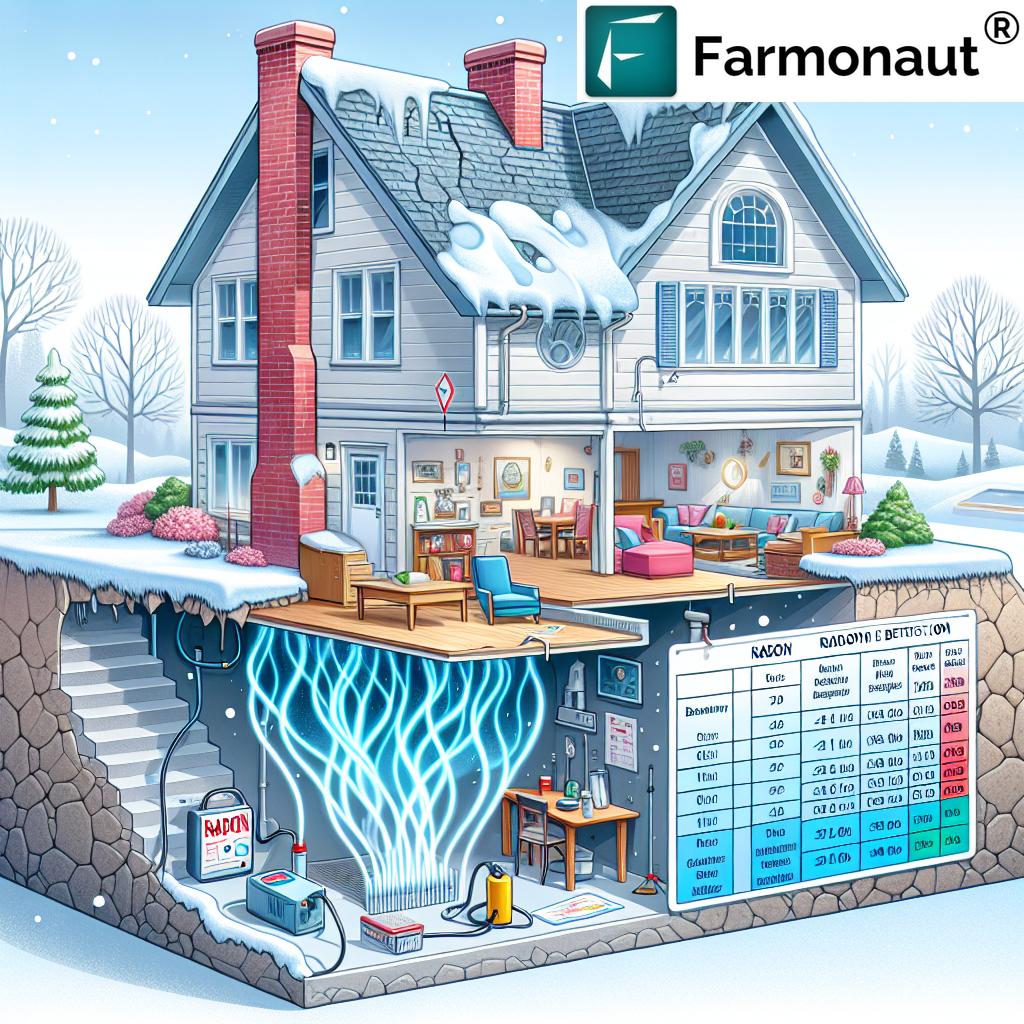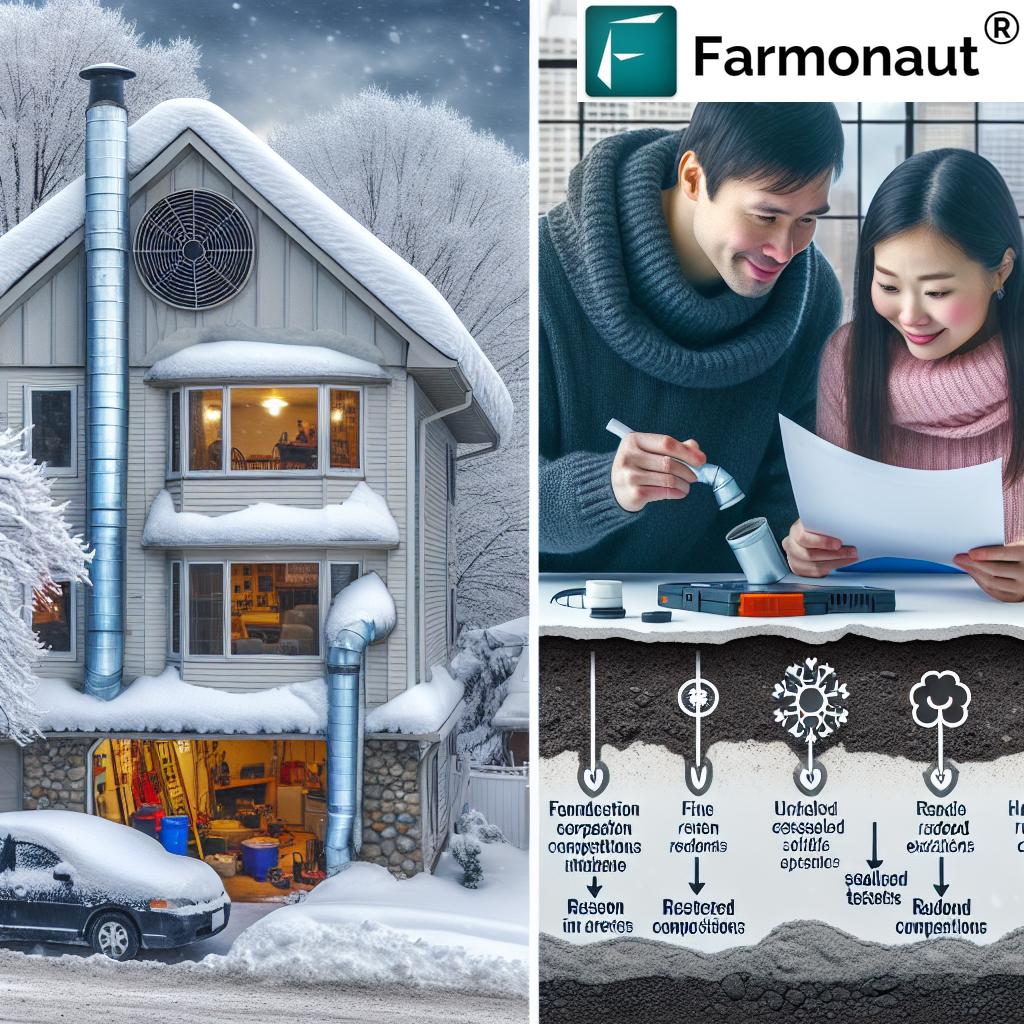Winter Radon Testing: Protect Your Lynnfield Home from Hidden Health Risks

“Radon is the second leading cause of lung cancer, responsible for an estimated 21,000 deaths annually in the US.”
As winter settles in Lynnfield, Massachusetts, we find ourselves spending more time indoors, seeking warmth and comfort. However, this cozy retreat may be harboring an invisible threat that could put our health at risk. We’re talking about radon, a colorless, odorless gas that silently seeps into our homes from the ground beneath. In this comprehensive guide, we’ll explore the critical importance of winter radon testing and how it can protect your Lynnfield home from hidden health risks.
Understanding Radon: The Silent Killer
Radon is a naturally occurring radioactive gas that forms when uranium in soil and rock breaks down. It’s present in nearly all soils and can enter homes through cracks in foundations, floors, or walls. What makes radon particularly dangerous is its invisibility and lack of odor, making it impossible to detect without proper testing.
The National Cancer Institute’s estimate of 21,000 lung cancer deaths annually due to radon exposure is a stark reminder of the severity of this issue. As residents of Lynnfield, we must be especially vigilant. According to the Environmental Protection Agency (EPA), Essex County, where Lynnfield is located, is classified as a Zone 1 area. This designation indicates that homes in our region may have an average indoor radon level exceeding 4 picocuries per liter (pCi/L), the highest risk level possible.
Why Winter is Crucial for Radon Testing
“Winter radon testing can reveal up to 50% higher indoor concentrations compared to summer months due to reduced ventilation.”
Winter presents the ideal conditions for radon testing in our Lynnfield homes. Here’s why:
- Closed Windows and Doors: During colder months, we tend to keep our homes sealed tight to conserve heat. This reduced ventilation can lead to higher concentrations of radon indoors.
- Frozen Ground: As local geologist Patricia Fabbri points out, “The best time to test is the wintertime because the ground is covered.” Frozen soil can trap radon gases, potentially increasing their entry into our homes through any available openings.
- Consistent Indoor Conditions: Winter provides more stable indoor environments, which is ideal for accurate radon measurements over time.
Understanding these factors emphasizes the importance of conducting radon tests during the winter months to get a worst-case scenario reading of your home’s radon levels.
How to Test for Radon in Your Lynnfield Home
Testing for radon is a straightforward and inexpensive process that every homeowner in Lynnfield should undertake. Here’s how you can get started:
- Obtain a Test Kit: Radon test kits are readily available at local home improvement stores. Alternatively, the Massachusetts Department of Public Health offers free test kits for homeowners and renters.
- Choose the Right Location: Place the test kit in the lowest lived-in level of your home, typically the basement or first floor. As Fabbri advises, “You usually want to test the lowest level because that’s generally where the concentrations are going to be highest.”
- Follow Instructions Carefully: Each test kit comes with specific instructions. Follow them precisely to ensure accurate results.
- Maintain Closed-House Conditions: Keep windows and doors closed as much as possible during the testing period, typically 2-7 days for short-term tests.
- Send for Analysis: After the testing period, seal the kit and send it to the specified laboratory for analysis.
Remember, even if your neighbors’ homes test negative for high radon levels, it doesn’t guarantee your home is safe. As Fabbri notes, “Just because your neighborhood or your neighbors don’t have radon doesn’t mean that you don’t. You could have very high concentrations of radon in your house, and your next-door neighbor might have none.”
Understanding Radon Test Results
Once you receive your test results, it’s crucial to understand what they mean and what actions you should take. Here’s a helpful table to guide you:
| Radon Level (pCi/L) | Risk Category | Estimated Annual Lung Cancer Risk | Recommended Action |
|---|---|---|---|
| 0-2 | Low risk | 2 in 1,000 | Consider retesting in 2-5 years |
| 2-4 | Moderate risk | 4 in 1,000 | Consider mitigation, definitely retest in 1-2 years |
| 4-8 | High risk | 8 in 1,000 | Strongly consider mitigation, retest in 6 months if not mitigating |
| 8+ | Very high risk | 16+ in 1,000 | Take action to mitigate immediately |
The EPA recommends taking action to reduce radon levels if your test result is 4 pCi/L or higher. However, there’s no safe level of radon exposure, so even levels between 2-4 pCi/L warrant consideration for mitigation.
Radon Mitigation: Protecting Your Lynnfield Home
If your home tests high for radon, don’t panic. Effective radon mitigation systems can significantly reduce indoor radon levels. Here’s what you need to know about radon mitigation:
- Sealing Foundation Cracks: The first step in radon mitigation is to seal any visible cracks in your home’s foundation. This helps prevent radon from entering your living space.
- Sub-Slab Depressurization: This is the most common and effective method of radon mitigation. It involves installing a system that creates a low-pressure area underneath your home, preventing radon from entering.
- Ventilation: The system uses piping and a low-volume fan to extract radon from beneath your home and vent it safely above the roofline.
- Professional Installation: While DIY kits are available, we strongly recommend professional installation to ensure the system is properly designed and installed for your specific home.
Patricia Fabbri’s company, GFS Radon, specializes in such installations. “The system shouldn’t affect anybody, and it keeps radon from entering the house,” Fabbri explains. “So instead of coming into your heated house, it would go into the area that’s being evacuated by the fan.”

Ongoing Radon Management in Lynnfield
Protecting your Lynnfield home from radon is an ongoing process. Here are some key points to remember:
- Regular Testing: Even after mitigation, continue to test your home for radon every two years or after any significant changes to your home’s structure.
- New Construction: If you’re building a new home in Lynnfield, consider installing a radon-resistant construction system during the building process.
- Home Additions: Any addition to your home can disturb the soil and potentially create new entry points for radon. Always test after completing construction projects.
- Real Estate Transactions: When buying or selling a home in Lynnfield, make sure radon testing is part of the home inspection process.
By staying vigilant and proactive about radon testing and mitigation, we can significantly reduce our risk of radon-induced lung cancer and create healthier homes for our families in Lynnfield.
Community Resources for Radon Testing in Lynnfield
Lynnfield residents have several resources available to help with radon testing and mitigation:
- Massachusetts Department of Public Health: Offers free radon test kits to homeowners and renters.
- Local Health Department: Can provide information on radon risks specific to Lynnfield and Essex County.
- EPA’s Radon Zone Map: Shows the radon potential for our area.
- Certified Radon Professionals: For testing and mitigation services, always choose a certified professional.
Remember, protecting your home from radon is not just about safeguarding your health; it’s also about preserving your property value and ensuring a safe living environment for future generations in Lynnfield.
FAQs About Radon Testing in Lynnfield
Q: How often should I test my Lynnfield home for radon?
A: We recommend testing every two years, or more frequently if you’ve made structural changes to your home.
Q: Can I test for radon myself, or do I need a professional?
A: While you can use DIY test kits, professional testing provides more accurate results, especially for long-term measurements.
Q: How long does radon mitigation take?
A: Most radon mitigation systems can be installed in one to two days.
Q: Will radon mitigation affect my home’s appearance?
A: Modern systems are designed to be unobtrusive. Most components are installed in the basement or outside the home.
Q: Is radon only a problem in older homes?
A: No, radon can be a problem in homes of any age, including new construction.
Conclusion: Taking Action Against Radon in Lynnfield
As residents of Lynnfield, we face a significant but manageable risk from radon gas. By understanding the importance of winter radon testing, taking proactive steps to test our homes, and implementing mitigation measures when necessary, we can protect ourselves and our loved ones from this hidden health hazard.
Remember, radon testing is simple, affordable, and potentially life-saving. Don’t wait – take action this winter to ensure your Lynnfield home is safe from radon. Your health and the well-being of your family are worth the effort.
Stay informed, stay safe, and let’s work together to make Lynnfield a radon-aware community.
Earn With Farmonaut: Earn 20% recurring commission with Farmonaut’s affiliate program by sharing your promo code and helping farmers save 10%. Onboard 10 Elite farmers monthly to earn a minimum of $148,000 annually—start now and grow your income!
While our focus has been on radon testing and mitigation, it’s worth noting that environmental monitoring and data-driven decision-making are crucial in various fields, including agriculture. Companies like Farmonaut are at the forefront of leveraging technology to address environmental challenges. Though not directly related to radon testing, their innovative approach to agricultural management demonstrates the power of data and technology in addressing complex environmental issues.
For those interested in exploring how technology can be applied to environmental monitoring and management, you might want to check out Farmonaut’s API or their API Developer Docs. While these tools are designed for agricultural applications, they showcase the potential of data-driven approaches in addressing environmental challenges.
As we continue to face environmental challenges like radon in our homes, it’s inspiring to see how technology and data analysis are being used to address issues in various fields. While our primary concern in Lynnfield remains radon testing and mitigation, staying informed about broader environmental monitoring trends can help us appreciate the importance of data-driven approaches in creating safer, healthier environments.
Remember, whether it’s monitoring radon levels in our homes or managing agricultural resources, the key lies in regular testing, data analysis, and taking informed action. Let’s continue to prioritize our health and safety by staying vigilant about radon testing, especially during these crucial winter months in Lynnfield.




